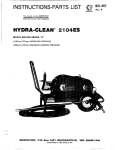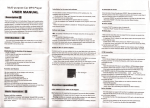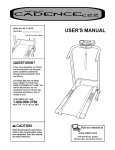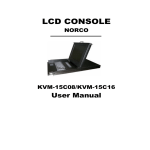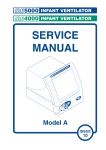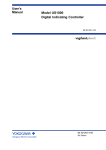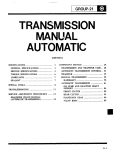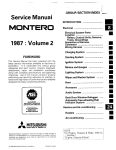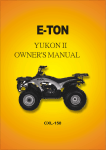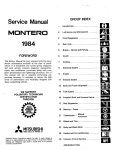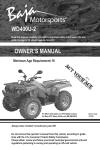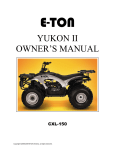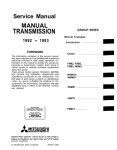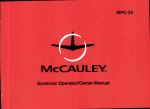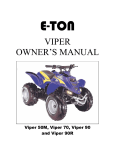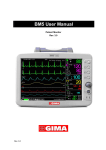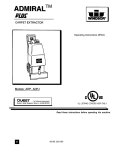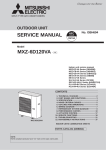Download 1. Introduction & Master Troubleshooting - Pajero 4x4 Off
Transcript
x NrJDAA-A GROUP INDEX Service Manual Introduction and Master Troubleshooting MONTCRO ......*....*...*.. Lubrication and Maintenance . .. .. .. .. m. Front Suspension .. .. ... . ... . ... . ... .. .. .. .. . . y 1989 : Volume 1 FOREWORD This Service Manual has been prepared with the latest service information available at the time of publication. It is subdivided into various group categories and each section contains diagnosis, disassembly, repair, and installation procedures along with complete specifications and tightening references. Use of this manual will aid in properly performing any servicing necessary to maintain or restore the high levels of performance and reliability designed into these outstanding vehicles. Rear Axle *.......*.......*................a.....*.. Srakes- Service Parking . .. .. .. .. .. .. .. .. .. .. .. .. .. .. & Clutch ................................................ Hi Cooling ............................................. w Engine ............................................... m Intake and Exhaust ,.......*..........*...... ml Fuel System . . .. .. .. .. .. .. ... . ... . .. . ... .. .. .. ... . mE Propeller Shaft and Universal Joint Rear Suspension Power Steering A m .. .. . ... m; .. .. .. .. . ... . ... . ... .. .. . ... .. mt ... . ..a*........................ m . Transmission - fity$tic n 4liP WESUPPORT VOLUNTARY TECHNICIAN CE,TT,flCA~ONMROUGH Wheels and Tires ............................. FP Body .................................................. m Heater and Air Conditioning Inr Mitsubishi Motors corporation reserves the right to make changes in design or to make additions to or improvements in its products without imposing any obligations upon itself to install them on its products previously manufactured. Q 198’8 Mitsubishi Motors Corporation Printed ........... p!’ Emission Control Systems .............. &!!!! MITSUBISHI MOlUR SALES OF AMERICR . .. .. .. ... ... &!a in Japan NOTE For Electrical refer to .._ Volume-2 “Electrical” ~~~~ -~-L 2 -.._i._-- - --em._. INTRODUCTION AND MASTER TROUBLESHOOTING - How To Use This Manual HOW TO USE THIS MANUAL CONTENTS The preceding page contains the GROUP which lists the group title and group number. INDEX PAGE NUMBERS All page numbers consist of two sets of digits separated by a dash. The digits preceding the dash identify the number of the group. The digits following the dash represent the consecutive page number within the group. The page numbers can be found on the top left or right of each page. gg$I! NWS&Wl g- LIMIT Shows the standard for judging the quality of a part or assembly on inspection and means the maximum or minimum value within which the part or assembly must be-kept functionally or in strength. It is a value established outside the range of standard value. TEXT Unless otherwise specified, each service procedure covers all models. Procedures covering specific models are identified by the model codes, or similar designation (engine type, transmission type, etc.). A description of these designations is covered in this unit under “VEHICLE IDENTIFICATION”. TROUBLESHOOTING Troubleshootings are classified into master troubleshooting and group troubleshooting and located as follows: The master troubleshooting is prepared when the trouble symptom relates to two or more groups and given in MASTER TROUBLESHOOTING. The group troubleshooting guide is prepared for causes of problems related to that individual group only; a troubleshooting guide is prepared for each appropriate group. incidental operation rformed before re- Removal steps : The numbers before part names b correspond to numbers in the illustration and indicate the order of removal. Disassemblv steos : The numbers before oat-t names co&pond to num6& in the illustration, and indicate the order of’disassembly. I ---I-- Installation steps : This is provided if installation cannot be made in the reverse order of “Removal steps”; omitted if installation in the reverse order of “Removal steps” is possible. Reassembly steps : This is provided if reassembly cannot be made in the reverse order of “Disassembly steps”: omitted if reassembly in the reverse order SERVICE PROCEDURES The sewice steps are arranged in numerical order and attentions to be paid in performing vehicle service are described in detail in SERVICE POINTS. DEFINITION OF TERMS STANDARD VALUE indicates the value used as the standard for judging the quality of a part or assembly on inspection or the value to which the part or assembly is corrected and adjusted. It is given by tolerance. The following abbreviations are used in this manual for classification of model ~! E-m+ types. M/T : Indicates the manual transmission, or models equipped with the manual transmission. A/T : Indicates the automatic transmission, or models equipped with the automatic transmission. F.B.C. : Indicates the feed back carburetor, or engines equipped with the feed back carburetor. M.P.I. : Indicates the multi-point injection, or engines equipped witkthe multi-point injection. 2.6 L Engine : Indicates the 2.6 liters (155.9 cuin.) engine, or a model equipped with such an engine. 3.0 L Engine : Indicates the 3.0 liters (181.4 cu.in.) engine, or a model equipped with such an engine. g&is : g ’ sar-= m. Ez INTRODUCTION AND MASTER TROUBLESHOOTING - How To Use This Manual Page number Group title t 7-io COOLING Section title - Thedostat I THERML vrra-r . -. REMOVAL AND INSTALLATlON Indicates tightening torque I Repair shown. kit or set parts are fOnlv verv freouentlv - This number corresponds to the number in “Removal steps”, “Disassembly steps”, “Installation steps” or “Reassembly steps”. 1. Connection of enginecoolant temperature syitch connector (Vehicles with an air condition- +ee 3. Water outlet 4. Water outlet 5 Thermostat fitting fitting gasket I L SERVICE S. POINTS INSTALIATION Install the thermostat caution The thermostat ensure OF INSTALLATIONOF THERMOSTAT that to the intake manifold as illustrated. Range tits over the the thermostat is not installed manifold seat; at an angle. An explanation of procedures, regarding removal, installation. and reassembly. notes, etc. disassembly 3 ,, i - 4 ./a .*, ,., L INTRODUCTION AND MASTER TROUBLESHOOTING -Vehicle Identification VEHICLE IDENTIFICATION VEHICLE IDENTIFICATION NUMBER LOCATIONm.. The vehicle identification number (V.I.N.) is located attached to the left top side of the instrument panel. on a plate -- VEHICLE IDENTIFICATION CODE CHART PLATE All vehicle identification number is a code which T - 3rd digit Vehicle type 4 Multipurpose vehicle (MW 7Truck 1 Ibs. and with hydraulic brakes G50016000 Ibs. and with hydraulic brakes t numbers contain 17 digits. The ve!h% tells country, make, vehicle type, etc. I--- \ 6th digit 7th digit Price class Body 4High 5Premium 33-door metaltopor van 8th digit 9th digit / 10th digit 1 Engine 1 zi$c” / Efe’ cu.in.1 S3.0liters (181.4 cuin.) 1 3 12th thru 17th digit I-Plant Serial number JNagoya -3 000001 to 999999 9 X NOTE ““Check digit” means a single number or letter)( used to verify the accuracy of transcription number. ( TSB Revision 11th digit ! of vehicle identification -. INTRODUCTION AND MASTER TROUBLESHOOTING VEHICLE FEDERAL \DENTlFlCATlON NUMBER - Vehicle Identification 5 LIST NWCG VIN (except sequence number) Brand q KJ JA7FJ43E JA7FJ43S 0 KJ JA7FJ43S 0 KJ JA7FJ53S Cl KJ JA4GJ41 S 17 KJ JA4GJ41 S 0 KJ JA4GJSlSCiKJ MITSUBISHI MONTERO \ Engine displacement Model code 2.555 liters (155.9 cu.in.) L042GTNJLF 2.972 liters (181.4 cub.) L141GTNJLF L141 GTRJLF L141 GTRULF Ll46GVMNJLF L146GVMRJLF L146GWMRULF Engine displacement Model code L CALIFORNIA (Can also be sold in Federal states.] VIN (except sequence number) JA7FJ43E 0 KJ Brand I JA7FJ43S q KJ JA7FJ43S q KJ JA7FJ53S 0 KJ JA4GJ41 S 0 KJ JA4GJ41 S q KJ JA4GJ51 S Cl KJ I MITSUBISHI MONTERO 2.555 liters (155.9 cu.in.) 2.972 liters (181.4 win.) I L042GTNJLH .~ L141 GTNJLH L141GTRJLH L141 GTRULH L146GVMNJLH Ll46GVMRJLl-l L146GWMRULH VEHICLE INFORMATION CODE PLATE NN!CO.- Vehicle information code plate is riveted on the cowl top outer panel (2.6L Engine) or front end upper bar (3.OL Engine) in the engine compartment. The plate shows model code, engine model, transmission model, and body color code. mc I A MllSUBlSHl w-B-_1 .---I -----xv2 ^ 1. MODEL L146G 2. 6672 VMNJLF I I ENGINE L 3. V5MTl TRANS AXLE 4. Engine model -L COLOR, TRIM OPT Transmission model H84 L HlXH84X85 Monotone exterior color code Two-tone color code /-T___ Exterior code --: Two-tone exterior isshown by the exterior code followed by the two color codes. mevision 6 INTRODUCTION AND MASTER TROUBLESHOOTING - Vehicle Identification CHASSIS NUMBER STAMPING LOCATION The chassis number is stamped the right rear wheel. CHASSIS NUMBER CODE CHART L141 I NOOCEon the side of the frame near ._ v KJOOOOOI I I I VEHICLE SAFETY CERTIFICATION LABEL NWCF The vehicle safety certification label is attached to face of left door pillar. This label indicates the month and year of manufacture, Gross Vehicle Weight Rating (G.V.W.R.), front and rear Gross Axle Weight Rating (G.A.W.R.), and Vehicle Identification Number (V.I.N.). ENGINE MODEL STAMPING The engine model is stamped top edge of the cylinder block liter engines, it is stamped at cylinder block. These engine model numbers ~3.0 L Engine> Nwce- on the right front side on the (for M-liter engines). For 3.0the right rear of the top of the are as shown in the following. 1 Engine model Engine displacement G54B 2.555 6G72 2.972 liters (181.4 cu.in.) liters (155.9 cu.iiTI The engine serial number is stamped near the engine number, and the serial number cycles, as shown below. model _ ~- Engine serial number Number cycling AA0201 AA0201 to YY9999 / Lo ABOOOl I 1 LmBAOOOl -..:-:-- I ----3 A.49989 ---+ AY9999 ---+ YY9999 __. 1- INTRODUCTION AND MASTER TROUBLESHOOTING - Vehicle Identification BODY COLOR CODE Exterior code Wonotone C46 H84 R82 s55 T86 wo9 R48 x15 rwo-tone Cl XC46X85 H 1XH84X85 R2XR82X85 Sl XS55X85 T6HT86H84 W6XWO9X85 X2HX15H84 A) : Metallic paint r Tss Revision Body color Brown(M) Silver(M) Red Beige(M) Blue(M) White Red (M) Black Brown(M)/ Black Silver(M)/ Black Redl Black Beige (MM Black Blue(M)/ Silver(M) White/ Black Black/ Silver(M) 7 A IV ~_-_ .L. sYa-r*au.rd.. ._,a-- A _- 8 INTRODUCTION AND MASTER TROUBLESHOOTING PRECAUTIONS - Precautions Before Service BEFORE SERVICE PROTECTING THE VEHICLE WmoAAK If there is a likelihood of damaging painted or interior parts during service operations, protect them with suitable covers (such as seat covers. fender covers, etc.). REMOVAL AND DISASSEMBLY When checking a malfunction. find the cause of the problem. If it is determined that removal and/or disassembly is necess&y, perform the work by following the procedures contained in this Workshop Manual. If punch marks or mating marks are made to avoid error in assembly and facilitate the assembly work, be sure to make them in locations which will have no detrimental effect on performance and/or appearances. If an area having many parts, similar parts, and/or parts which are symmetrical right and left is disassembled, be sure to arrange the parts so that they do not become mixed during the assembly process. I. Arrange the parts removed in the proper order. 2. Determine which parts are to be reused and which are to be replaced. 3. If bolts, nuts, etc., are to be replaced, be sure to use only the exact size specified. SPECIAL TOOLS If other tools are substituted for the special tools to do service or repair work, there is the danger that vehicle parts might be damaged, or the mechanic might be injured; therefore, be sure to use the special tool whenever doing any work for which the use of one is specified. PARTS TO BE REPLACED If any of the following parts are removed, replaced with new parts. I. Oil seals 2. Gaskets (except rocker cover gasket) 3. Packings 4. O-rings 5. Lock washers 6. Cotter pins 7. Self-locking nuts they must be INTRODUCTION AND MASTER TROUBLESHOOTING - Precautions Before Service 9 genuine parts PARTS When replacing parts, use MITSUBISHI VEHICLE WASHING If high-pressure car-washing equipment or steam car-washing equipment is used to wash the vehicle, be sure to maintain the spray nozzle at a distance of at least 300 mm (11.8 in.) from any plastic parts and all opening parts (doors, luggage compartment, etc.). nm (in.) smo59 SERVICING ELECTRICAL SYSTEM 1. Note the following before proceeding with work on the electrical system. Note that the following must never be done: Unauthorized modifications of any electrical device or wiring, because such modifications might lead to a vehicle malfunction, over-capacity or short-circuit that could result in a fire in the vehicle. 2. When servicing the electrical system, disconnect the negative cable terminal from the battery. Caution 1. Before connecting or disconnecting the negative cable, be sure to turn off the ignition switch and the fighting switch. (If this is not done, there is the possibility of semiconductor parts being damaged.) 2. After completion of the work steps [when the battery’s negative (-) terminal is connected], warm up the engine and allow it to idle for approximately five minutes under the conditions described below, in order to stabilize engine control conditions, and then check to be sure that the idling is satisfactory. For 3.OL Engine models: If the engine rpm is high, switch OFF the ignition switch, and then, after switching it ON again, let the engine idle for 2 or 3 minutes. This will cause the engine rpm to decrease about 100 rpm, so repeat this procedure until the prescribed idling speed is reached. Engine coolant temperature : 85”-95°C (‘l85403”F) Lights, accessories : OFF Transmission : neutral position (Automatic transmission models: “IV or “P”J Steering wheel : neutral (center) position 1 TSB Revision 10 INTRODUCTION AND MASTER TROUBLESHOOTiNG - Precautions Before Service WIRING HARNESSES 1. Secure the wiring harnesses by using clamps. However, for any harness which passes to the engine or other vibrating parts of the vehicle, allow some slack within a range that does not allow the engine vibrations to cause the harness to come into contact with any of the surrounding parts. Then secure the harness by using a clamp. In addition, if a mounting indication mark (yellow tape) is on a harness, secure the indication mark in the specified location. 2. If any section of a wiring harness contacts the edge of a part, or a corner, wrap the section of the harness with tape or something similar in order to protect it from damage. F1617 3. When disconnecting a connector, connector, not the harness. 4. be sure to pull only the Disconnect connectors which have catches by pressing the direction indicatedby the arrows in the illustration. in INTRODUCTION AND MASTER TROUBLESHOOTING - Precautions Before Servicre 11 5. Connect connectors which have catches connectors until they snap. by inserting the ELECTRICAL COMPONENTS 1. When installing any of the vehicle parts, be careful pinch or damage any of the wiring harnesses. not to 2. Sensors, relays, etc., are sensitive to strong impacts. Handle them with care so that they are not dropped mishandled. or I 3. The electronic parts used for relays, etc., are sensitive to heat. If any service which causes a temperature of 80°C (176°F) or more is performed, remove the part or parts in question before carrying out the service. FUSES AND FUSIBLE LINKS cwE331 I I 1. If a blown-out fuse is to be replaced, be sure to use only a fuse of the specified capacity. If a fuse of a capacity larger than that specified is used, parts may be damaged and the circuit may not be protected adequately. Caution 10A 15A cnlY589 1 (SB Revision 1. If a fuse is blown-out, be sure to eliminate the cause of the problem before installing a new fuse. 2. Check the condition of fuse holders. If rust or dirt is found, clean metal parts with a fine-grained sandpaper until proper metal-to-metal contact is made. Poor contact of any fuse holder will often lead to voltage drop or heating in the circuit and could result in improper circuit operation. 1 12 INTRODUCTION AND MASTER TROUBLESHOOTING - Precautions Before Service Permissible Nominal size 0.3 mm2 0.5 mm2 0.85 mm* 1.25 mm2 2.0 mm* 3.0 mm2 5.0 mm2 SAE current I Other areas 2. If additional optional equipment is to be installed in the vehicle, follow the procedure listed in the appropriate instruction manual; however, be sure to pay careful attention to the following points: (1) In order to avoid overloading the wiring, take the electrical current load of the optional equipment into consideration, and determine the appropriate wire size. (2) Where possible, route the wiring through the existing harnesses. (3) If an ammeter or similar instrument is to be connected to a live-wire circuit, use tape to protect the wire, use a clamp to secure the wire, and make sure that there is no contactwith any other parts. (4) Be sure to provide a fuse for the load circuit of the optional equipment. TUBES AND OTHER RUBBER PARTS Be careful to avoid spilling any gasoline, parts, they might be adversely affected. oil, etc., or rubber LUBRICANTS In accordance with the instructions in this Service Manual, apply the specified lubricants in the specified locations during assembly and installation. BRAKE FLUID Be careful to avoid spilling surfaces, because the paint damaged. any coat brake might fluid on painted be discolored or INTRODUCTION AND MASTER TROUBLESHOOTING - t+mwtions Before Service ‘I3 DOING SERVICE WORK IN GROUPS OF TWO OR MORE TECHNICIANS If the service work is to be done by two or more technicians working together, extra caution must be taken. NOTE ON INSTALLATION OF RADIO EQUlPM$ihlThe computers of the electronic control system has been designed so that external radio waves will not interfere with their operation. However, if antenna or cable of amateur transceiver etc. is routed near the computers, it may affect the operation of the computers. even if the output of the transceiver is no more than 25W. To protect each of the computers from interference by transmitter (hum, transceiver, etc.). the following should be observed. 1. Install the antenna on the roof or rear bumper. 2. Because radio waves are emitted from the coaxial cable of the antenna, keep it 200 mm (8 in.) away from the computers and the wiring harness. If the cable must cross the wiring harness, route it so that it runs at right angles to the wiring harness. 3. The antenna and the cable should be well matched, and the standing-wave ratio” should be kept low. 4. A transmitter having a large output should not be installed in the vehicle. 5. After installation of transmitter, run the engine at idle, emit radio waves from the transmitter and make sure that the engine is not affected. *STANDING-WAVE RATIO If an antenna and a cable having different impedances are connected, the input impedance Zi will vary in accordance with the length of the cable and the frequency of the transmitter, and the voltage distribution will also vary in accordance with the location. The ratio between this maximum voltage and minimum voltage is called the standing-wave ratio. It can also be represented by the ratio between the impedances of the antenna and the cable. The amount of radio waves emitted from the cable increases as the standing-wave ratio increases, and this increases the possibility of the electronic components being adversely affected. 1 TSB Revision I ,’ i 1; h-J 14 ” ^. INTRODUCTION AND MASTER TROUBLESHOOTING - Treatment Before I AftertheFotiingofastmsm TREATMENT BEFORE/AFTER THE FORDING OF A STREAM INSPECTION AND SERVICE BEFORE FORDING NOW%A STREAM Vehicles which are driven through water, or which may possibly be driven through water, should be subjected to the following inspections and maintenance procedures in advance. e Seal the speedometer cable with a water-resistant grease or tape. a Inspect the dust boots and breather hose for cracks or damage, and replace them if cracks or damage are found. ,- Steering joint assembly / . 1^. 1 Drive shaft boot -\l(. ‘/ Torsion bar dust cover OOW528 ( TSB Revision dometer \ 1Breath& cable hose== 1 ~_ - INTRODUCTION AND MASTER TROUBLESHOOTING l TSB Revision - Treatment Before / AftertheFordingofaStream I5 Apply grease to the lubricating points of the front suspension, steering linkage and propeller shaft. 16 INTRODUCTION AND MASTERTROUBLESHOOTING - Treatment Before I AftertheFordingofaStream INSPECTION AND SERVICE AFTER FORDING A STREAM After fording a stream, check the following points. If abnormal condition is evident, clean, replace or lubricate. Check for water. mud. sand. etc. in the rear brake drum. clutch housing, &tarte; mot&, brake pipe and fuel pipe: Check for water in the fluid or oil inside the front differential. rear differential, transmission and transfer case. Apply grease to the lubricating points of the front suspension, steering linkage and propeller shaft. Check all boots and breather hoses for cracks and damage. rTSB Revi = INTRODUCTION AND MASTER TROUBLESHOOTING - Towing and Hoisting TOWING 17 AND HOISTING This vehicle can only be towed from the front with conventional sling-type equipment and tow chain with grab hooks. If a vehicle is towed from the rear, use a tow dolly. A lumber spacer (4” x 4” x 55” wood beam) should be placed forward of under guard and under towing hook/shipping tie down hook. Then, attach J-hook to the lower arm. A safety chain system must be used. This system must be completely independent. of the primary lifting and towing attachment. Care must be taken in the installation of safety chains to insure they do not cause damage to bumper, painted surfaces or lights. LIFTING-GROUND CLEARANCE Towed vehicle should be raised until wheels are a minimum of 10 cm (4 in.) from the ground. Be sure there is adequate ground clearance at the opposite end of the vehicle, especially when towing over rough terrain or when crossing sharp rises such as curbs. If necessary, ground clearance can be increased by removing the wheels from the lifted end of the disabled vehicle and carrying the lifted end closer to the ground. A 20 cm (8 in.) ground clearance must be maintained between brake drums and ground. FRONT TOWING PICKUP The vehicle may be towed on its rear wheels for extended distances, provided the parking brake is released. Make cartain the transmission remains in “NEUTRAL”. SAFETY PRECAUTIONS The following precautions should be taken when towing the vehicle. 1. Remove exhaust tips and any other optional equipment, that interface with the towing sling. Padding (heavy shop towel or carpeting) should be placed between the towing sling cross bar and any painted surfaces, and bumper surfaces. 2. A safety chain system completely independent of the primary lifting and towing attachment must be used. 3. Any loose or protruding parts of damaged vehicle such as hoods, doors, fenders, trim, etc., should be secured prior to moving the vehicle. 4. Operator should refrain from going under a vehicle unless the vehicle is adequately supported by safety stands. 5. Never allow passengers to ride in a towed vehicle. 6. State and local rules and regulations must be followed when towing a vehicle. 1 TSBRevision .$i ~[ 18 r INTRODUCTION AND MASTER TROUBLESHOOTING and Hoisting - Towing HOISTING POST TYPE Special care should be taken when raising the vehicle on a frame contact type hoist. The hoist must be equipped with the proper adapters in order to support the vehicle at the proper locations. (Shown in the illustration) Conventional hydraulic hoists may be used after determining that the adapter plates will make firm contact with the side frame. ._ FLOOR JACK A regular floor jack may be used under the front crossmember or rear axle housing. Caution 1. A floor jack must never be used on any part of the underbody. 2. Do not attempt to raise one entire side of the vehicle by placing a jack midway between front and rear wheels. This practice may result in permanent damage to the body. EMERGENCY JACKING Jack receptacles are located at the No. 2 crossmember and rear axle housing to accept the jack supplied with the vehicle for emergency road service. Always block the opposite wheels and jack only on a level surface. FRAME CONTACT SUPPORT LOCATIONS 1,175 mm (46.3 in.) Wheel base 2.350 mm (92.5 in.) Sectlon NOTE The locations of the support point shown as Section A-A are the same as those of the twin post hoist shown in the next paw. 1 TSB Revision I - A-A . INTRODUCTION LIFTIYG AND JACKING <2.6L Engine> <3.OL Engine> C m AND MASTER TROUBLESHOOTING SUPPORT LOCATIONS Twin post hoist Floor jack @ Emergency jacking (jack supplied TSB Revision with the vehicle) - Towing and Hoisting 19 20 INTRODUCTION AND MASTER TROUBLESHOOTING - General Data and Specifications GENERAL DATA AND SPECIFICATIONS <2-door NW- vehicles> Models L047.G ascription chicle dimensions mm (in.) Overall length Without spare tire With spare tire Overall width Overall height Wheelbase Tread Front Rear Overhang Front Rear Height at curb weight (wt.) Front bumper to ground Rear bumperto ground Minimum running ground clearance Angle of approach Angle of departure Ramp breakover angle T L141G TNSL F/H TNJL F/H TRJL F/W TRUL F/H 0 8 @ @ c3 @ 6 @ (9, 3,900 (153.5) 3,935 (154.9) 1,680 (66.1) 1,840 (72.4) 2,350 (92.5) 1,400 (55.1) 1,375 (54.1) 685 (27.0) 900 (35.4) 3,905 (153.7) 3,940(155.1) 1,680 (661) 1,850 (72.8) 2,350 (92.5) 1,400 (551) 1,415 (55.7) 685 (27.0) 905 (35.6) 3,905 (153.7) 3,940(155.1) 1,880 (66.1) 1,850 (72.8) 2,350 (92.5) 1,400(55.1) 1,415 (55.7) 685 (27.0) 905 (35.6) 3,905 (153.7) 3,940(155.1) 1,680 (66.1) 1,850 (72.8) 2,350 (92.5) 1,400 (55.1) 1,415 (55.7) 685 (27.0) 905 (35.6) @ 0 0 480(18.9) 440(17.3) 210(8.3) 490 (19.3) 450 (17.7) 215 (8.5) 490(19.3) 450(17.7) 215(8.5) 490 (19.3) 450 (17.7) 215 (8.5) 38” 28” 21° 38” 28” 21” 38” 28” 21” 8 38” 8 28” -33 21” hicle weights kg (Ibs.) Curb weight Gross vehicle weight rating Gross axle Front weight rating Rear 1,455 (3.207) 1,910(4.210) 1 ,I 00 (2.425) 1,450 (3.197) 2 Seating capacity ;--- -. . I TSB Revision 1,585 2,200 1,100 1,600 2 (3,494) (4,850) (2,425) (3,527) 1,600 2,200 1,100 1,600 2 I (3.527) (4,850) (2,425) (3,527) 1,605 2,200 1,100 1,600 2 (3,538) (4,850) (2,425) (3,527) INTRODUCTION AND MASTERTROUBLESHOOTING - L042G TNJL F/H TRJL F/H TRUL F/H G54B In-line OHC 4 91.1 mm(3.59in.j 98.0 mm (3.86 in.) 2,555 cm3 (155.9 cuin.) 8.7 1-3-4-2 7”BTDC 22” 6672 V-type, OHC 6 91.1 mm(3.59in.j 76.0 mm (2.99 in.) 2,972 cm3 (181.4cu.in.) 8.9 1-2-3-4-5-6 5”BTDC 22” 6672 V-type, OHC 6 91.1 mm(3.59in.) 76.0 mm (2.99 in.) 2,972 cm3 (181.4cu.in.) 8.9 I -2-345-5 5”BTDC i 2” 6672 V-type, OHC 6 91.1 mm(3.59in. 76.0 mm (2.99 in. 2,972 cm3 (181.4 cuin.) 8.9 1-2-3-4.5-8 5”BTDC +-2” KM145 S-speed manual V5MTl 5-speed manual KM148 &peed automatic KM148 &peed automatic 1st 2nd 3rd 4th 5th 3.967 2.136 1.360 1.ooo 0.856 3.918 2.261 1.395 1.000 0.829 2.826 1.493 1 .ooo 0.688 2.826 1.493 1.000 0.688 - Reverse High Low 3.587 1 .ooo 1.944 4.625 3.925 1.ooo 1.925 4.625 2.703 1 .ooo 1.925 4.625 2.703 1 .ooo 1.925 4.625 Dry single disc & diaphragm spring Dry single disc & diaphragm spring - P225ff 5Rl5 P235ff5Rl5 independent double-wishbone Independent Rigid axle Rigid axle Compression ratio Firing order Basic ignition timing Type Gear ratio Transmission Transfer case L141G TNSL FM Engine Model No. Type Number of cylinders Bore Stroke Piston displacement Transmission &transfer Model No. case Final ring gear ratio Clutch Type Chassis Tire size Front suspension Type double-wishbone Rear suspension Type Brakes Type Front Rear Power steering Gear type Gear ratio Fuel tank capacity 21 GeneralDataandSpecmcations liters (gals.) Disc Disc Drum Drum (Leading and trailing) (Leading and trailing) Integral type Integral type (Recirculating ball nut) (Recirculatingball nut) 16.4 16.4 60 (15.9) 75 (19.8) [ TSB Revision -_- 22 INTRODUCTION AND MASTER TROUBLESHOOTING <&door - General Data and Specifications vehicles> L146G VMNJL F/H L- chicle dimensions mm (in.) Overall length Withoutspare tire With spare tire Overall width Overall height Wheelbase Tread Front Rear Overhang Front Rear Height at curb weight Wt.) Front bumperto ground Rear bumper to ground Minimum running ground clearance Angle of approach Angle of departure Ramp breakover angle ,hicle weights kg (Ibs.) Curb weight Gross vehicle weight rating Gross axle weight rating Seating capacity Front Rear gine Model No. L _-. Type Number of cylinders Bore Stroke Piston displacement Compression ratio Firing order Basic ignition timing .- VMRJL F/H WMRUL F/H a @ 0 @ Q @ 8 @ @ 4,570 (179.9) 4,605 (181.3) 1,680 (66.1) 1,890 (74.4) 2,695 (106.1) 1,400 (55.1) I,41 5 (55.7) 745 (29.3) 1 ,I 65 (45.9) 4,570 ( 179.9) 4,605(181.3) 1,680 (66.1) 1,890 (74.4) 2,695(106.1) 1.400(55.1) 1,415 (55.7) 745 (29.3) 1,165(45.9) 4.570 (179.9) 4,605 (181.3) 1,680 (66.1) 1,890 (74.4) 2,695(106.1) 1,400(55.1) 1,415 (55.7) 745 (29.3) 1,165 (45.9) @ 0 @ 490 (19.3) 450(17.7) 215 (8.5) 490 (19.3) 450(17.7) 215 (8.5) 490 (19.3) 450 (17.7) 215 (8.5) 8 8 63 38” 28” 18” 38” 28 18” 38” 28” 18 1,780 (3,924) 2,400 (5,291) 1,100(2,425) 1,600 (3,527) 5 1,795 (3,957) 2,400 (5,291) 1,100(2.425) 1,600 (3,527) 5 1,805 2,400 1,100 1,600 5 6672 V-type, OHC 6 91 .I mm (3.59 in.) 76.0 mm (2.99 in.) 2,972 cm3 (181.4 cu.in.) 8.9 l-2-3-4-5-6 5”BTDC i2” 6672 V-type, OHC 6 91 .l mm (3.59 in.) 76.0 mm (2.99 in.) 2,972 cm3 (181.4 cuin.) 8.9 1-2-3-4-5-6 5”BTDC 22” : 3072 V-type, OHC 3 31 .l mm (3.59 in.) 76.0 mm (2.99 in.) 2,972 cm3 (181.4 cu.in.) 3.9 l-2-3-4-5-6 5”BTDC 22” -i 1 TSB Revision I (3,979) (5,291) (2,425) (3,527) INTRODUCTION AND MASTER TROUBLESHOOTING - General Dataand Swxifications 7 L146G VMNJL F/H Transmission &transfer Model No. 1St 2nd 3rd 4th 5th Reverse Transfer case High Low Final ring gear ratio Elutch Type KM148 4-speed automatic KM148 4-speed automatic 3.918 2261 1.395 1.000 0.829 3.925 1.000 1.925 4.625 2.826 1.493 1.ooo 0.688 2.826 1.493 1 .ooo 0.688 - 2.703 1.ooo 1.925 4.625 2.703 1 .ooo -1.925 4.625 P235ff 5 R 15 Type Rear suspension Independent Type Brakes Rigid axle Power steering Gear type Gear ratio Fuel tank capacity WMRUL F/H EMT1 5-speed manual Dry single disc & diaphragm spring Chassis Tire size Front suspension Type VMRJL F/H case Type Gear ratio Transmission Front Rear liter (gal.) doublewishbone Disc Drum (Leading and trailing) Integral type (Recirculating 16.4 92 (24.3) 1 TSB Revision ball nut) 23 24 INTRODUCTION AND MASTER TROUBLESHOOTING - Tightening Torque WasterTroubleshooting I TIGHTENING TORQUE Description Head mark Thread for general purposes (size x pitch) mm 6x1.0 8x 1.25 10x1.25 12x 1.25 14x 1.5 16x 1.5 18x 1.5 20x1.5 22x 1.5 24x 1.5 Description Taper thread for pipes (size) PT1/8 PT l/4 PT 3B Taper thread for dry sealed pipes (size) NF’TF l/16 NPTF l/8 NPTF l/4 Head mark f Nm ft.lbs. 3.0-3-s 7.9-12 16-23 29-43 46-70 67-l 00 100-150 150-190 ZOO-260 269-320 2.2-2.9 5.8-8.7 12-17 2’132 35-52 51-77 74-110 110-140 150-190 1go-240 Nm ftlbs. [ I Nm ft.lbs. 4.9-7.8 13-19 27-39 47-72 77-110 130-160 180-230 160-320 340-430 420-550 3.6-5.8 9.4-14 20-29 35-53 57-35 SO-120 130-170 1 go-240 250-320 310-410 Remarks 7.9-I 2 76-19 19-30 34-45 39-54 58-73 5.9-9.7 12-14 14-22 25-33 29-40 43-54 Internal Internal Internal Internal Internal Internal thread: thread: thread: thread: thread: thread: Aluminum Cast iron Aluminum Cast iron Aluminum Cast iron 4.9-7.8 7.9-12 7.9-12 16-1s 19-13 34-45 3.6-5.8 5.8-8.7 5.8-8.7 12-14 14-22 25-33 Internal Internal Internal Internal Internal Internal thread: thread: thread: thread: thread: thread: Aluminum Cast iron Aluminum Cast iron Aluminum Cast iron MASTER TROUBLESHOOTING NceKAAO ENGINE OVERHEATS Symptom Probable cause Engine overheats Cooling system faulty Incorrect ignition timing 1 TSB Revision Reference page or remedy INTRODUCTION AND MASTER TROUBLESHOOTING ENGINE WILL NOT CRANK OR CRANKS - Master Troubleshooting 25 SLOWLY Symptom Probable cause Reference page or remedy Engine will not crank or cranks slowly Starting system faulty 8-134.135 ENGINE WILL NOT START OR BE HARD TO START (CRANKS OK) Symptom Probable cause Reference page or remedy Engine will not start or be hard to start(Cranks OK) No fuel supply to carburetor or injection system 14-34,90 Carburetor or injection system problems 14-34,90 Ignition system problems 3-147 to 149 Vacuum leaks - Purge control valve hose - Vacuum hoses intake manifold - Air intake plenum Carburetor or throttle body EGRvalve l Repair as necessary l l Compression too low 3-11.65 ROUGH IDLE OR ENGINE STALL Probable cause Symptom Rough idle or engine stalls Vacuum leaks Purge control valve hose Vacuum hoses Intake manifold Air intake plenum Carburetor or throttle body EGRvalve l l Reference page or remedy Repair as necessary l l l l 1 Ignition system problems Idle speed set too low Idle~mrxture 1~ . too lean or too rich 8-147 to 149 1 O-10.14-62 14-11 Carburetor or fuel injection system problems m-34.90 Exhaust gas recirculation (EGR) system problems 25-17.32 Engine overheats 7-4 Compression 9-11, 65 too low 1 TSB Revision ‘p ? f! .., .-, _-_ ,_- ____ ____ _L( 26 INTRODUCTION AND MASTER TROUBLESHOOTlNG - Master Troubleshooting ENGINE HESITATES OR POOR ACCELERATION Symptom Engine hesitates or poor acceleration Reference page or remedy Probable cause -I 8-147 to 149 Ignition system problem Vacuum leaks Purge control valve hose Vacuum hoses - intake manifold Air intake plenum * Carburetor or throttle body EGRvalve Repair as necessary l l l l Air cleaner clogged 113.10 Fuel line clogged 1442.99 Carburetor or fuel injection system problem 14-34.90 Auxiliary acceleration 14-23 pump faulty (cold engine) Emission control system problem EGR system always on - High-altitude compensation (HAC) system problem 25-77.22.32 Engine overheats 7-4 Compression g-II.65 l too low ENGINE DIESELING I Symptom I Engine dieseling (runs after ignition switch is turned off) I Probable cause I I Reference page or remedy Carburetor problems 14-34 Incorrect ignition timing 8-14710 149 EXCESSIVE OIL CONSUMPTION Symptom Probable cause Reference page or remedy Excessive oil consumption Oil leak Repair as necessary Positive crankcaseventilation line clogged o-13 Valve stem seal worn or damaged Replace Valve stem worn Replace Piston ring worn or damaged 9-43 1 TSB Revision I -.. INTRODUCTION AND MASTER TROUBLESHOOTING POOR FUEL - Master Troubleshooting 27 MILEAGE Symptom Probable cause Reference page or remedy Poor fuel mileage Fuel leak Repair as necessary I 1 Air cleaner clogged 1 11-3.10 1 1 Ignition problems 1 8-147to 149 1 Carburetor or fuel injection system problems 1434.90 I 1g-II.65 1 1 22-2 I Clutch slips 16-4 Brakes drag 1 5-13 I I Compression too low Tires improperly inflated NOISE Noise Probable cause Reference page or remedy Loose bolts and nuts Retighten as necessary I 9-11 1 Enaine noise HARD STEERING Symptom Probable cause Reference page or remedy Hard steering Loose power steering oil pump belt 19-10 Low fluid level 19-11 Air in power steering system 19-11 Low tire pressure 22-2 Excessive turning resistance of upper or lower ball joint 2-27 Excessivelytight 1937 linkage ball joint Improperfrontwheel alignment 2-13 Excessive turning resistance of tie-rod ball joint 19-38 ’ No lubricantion Lubricate of tie-rod Sticky flow control valve 19-33 No lubrication of idler arm 19-39 ) TSB Revision I I INTRODUCTION MASTER TROUBLESHOOTING - Master Troubleshootha POOR RETURN OF STEERING WHEEL TO CENTER Symptom Probable cause Reference page or remedy Poor return of steering wheel to center improper front wheel alignment 2-13 Improper tire pressure 22-2 Damaged front wheel bearing 2-21 Probable cause Reference page or remedy Impropertire 22-2 POOR RIDING Poor riding pressure 22-4 lmbalanced wheels 1 Improper front or rear wheel alignment 1 2-13.17-3.6 1 Malfunctioning 1 2-27,174.a shock absorber 1 Broken or worn stabilizer j 2-36 1 Broken or worn torsion bar spring Loose suspension securing bolt(s) Retighten 1 Worn lower arm bushing / 231 I I I ABNORMAL TIRE WEAR Symptom Probable cause Reference page or remedy Abnormal tire wear Improper front or rear wheel alignment 2-l 3,17-3.6 Improper tire pressure 22-2 lmbalanced wheels 22-4 Loose wheel bearings 2-19 Malfunctioning 2-27. 174.8 shock absorber ROAD WANDER Symptom Probable cause Road wander Improper front or rear wheel alignment Reference page or remedy z 19-6 Excessive play of steering wheel Poor turning resistance of upper ball joint ~ Improper tire pressure / Loose or worn lower arm or upper arm bushing I Loose or worn wheel bearinas 2-13. 17-3,6 2-27 22-2 2-28.31 I 2-19 __ 1 ~- [ TSB Revision - rr. INTRODUCTION AND MASTER TROUBLESHOOTING VEHICLE - Master Troubleshootina 29 PULLS TO ONE SIDE Symptom Probable cause Reference page or remedy Vehicle pulls to one side Improper front or rear wheel alignment 2-l 3.17-3.6 lmbalanced or worn tires / 224 Uneven tire pressure 22-2 Excessive turning resistance of upper ball joint 2-27 Wheel bearing seizure 2-21 Broken or worn torsion bar spring 2-36 Bend front axle drive shaft 2-40 Deformed 230 lowerarm STEERING WHEEL SHIMMY Reference page or remedy Symptom Probable cause Steering wheel shimmy Improper front or rear wheel alignment 1 2-13,17-3,6 1 Improper tire pressure 1 22-2 I Imbalanced wheels Repair I 1 2-27 I 19% I Broken or weak stabilizer 1 2-39 I Worn lower arm or upper arm bushing I 2-28.31 1 I 2-27 I 1 Poorturning resistance of upper ball joint Excessive play of steering wheel \ Malfunctioning shock absorber / Broken or weak torsion bar spring or, leaf spring or coil spring / 2-36,17-4,9 Wear, play, or seizure of wheel bearing 2-19 Symptom Probable cause Reference page or remedy Bottoming Overloaded vehicle Correct Broken or weak torsion bar spring, leaf spring or coil spring 236.1749 BOTTOMING 1 Malfunctionina ( TSB Revision shock absorber 1 2-27,174 8 1 I”! 1: 1’ --30 -~~ INTRODUCTION AND MASTER TROUBLESHOOTING - Master Troubleshooting WHEEL BEARING TROUBLESHOOTING Trouble Symptom Probable cause Pitting Pitting occurs because of uneven rotation of race and bearing surfaces Excessive bearing preload Excessive load Flaking The surface peels because of uneven rotation of the race and bearing surfaces End of bearing life Improper bearing assembly Cracking Chipping or cracking of cage or roller edges Impact when bearing was installed (such as being hit with a hammer) Flat spotting When large load is applied, race and roller contact surfaces compress, forming indentations Excessive bearing preload Excessive load Vibration when bearings are not used, such as during shipment on freight cars, transport trucks, etc. Nicks Instead of rolling along race surface, rollers slide, thus damaging surface Improper grease Excessive bearing preload Excessive load Faulty oil seal Damage or wear caused by minute particles adhering to surfaces results in rough movement and such high temperatures that parts of surface melt Excessive variation of loads on bearings Use of grease other than that specified Improper grease ?ust, corrosion Appears on various areas of the bearing Use of grease otherthan that specified Faulty oil seal Presence of water or moisture Near Wear of surface areas caused by friction Improper grease Foreign matter Rust or corrosion due to moisture Use of grease otherthan that specified Faulty oil eal Xscoioration Grease discoloration results from grease deterioration which causes particles of pigment contained in grease to adhere to surfaces Heat discoloration will appear as a deep brown or purple Use of grease other than that specified Faulty oil seal Excessive bearing preload Excessive load






























